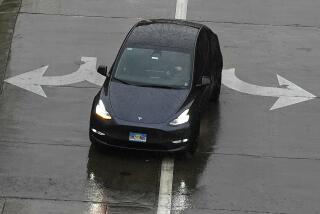Pickup, SUV Sales Buck Flat Trend for 1997
Sales of new cars in the U.S. remained flat for 1997, with continued strong performances by pickup trucks and sport-utility vehicles offsetting steady declines in passenger car sales.
An estimated 15.1 million new vehicles were sold last year, identical to the 1996 total, industry analysts said Tuesday. But light trucks and SUVs are expected to account for close to 45% the volume, up from 41% in 1996.
Analysts said 1998 is likely to be a repeat of the last two years but added that the relatively stable sales levels arenât a bad thing. Indeed, there have only been three other years when U.S. auto sales rose above the 15-million mark.
The strong sales are expected to continue as long as the economy remains stable and interest rates stay low.
âWhat weâre really looking at in 1998 is a year full of aggressive competitionâ as various auto makers seek to increase their share of the market at the expense of others, said Paul Ballew, chief economist for J.D. Power and Associates.
Car makers will be unable to raise prices for fear of losing sales to competitors, he said. At the same time, the Japanese and South Korean car companies are expected to boost imports to the U.S. to help offset sagging sales in economically troubled Asian markets.
âItâs going to be a lot more difficult for manufacturers, but a fantastic environment for consumers,â Ballew said. He predicted that car makers will offer more features without raising prices and said some companies could increase their rebates and other incentives to lure buyers.
South Koreaâs Hyundai Motor American Inc., in fact, did just that on Tuesday, announcing through its Fountain Valley-based U.S. import arm that it will give $1,000 rebates on all of its 1998 models. South Koreaâs won has fallen by 50% against the dollar over the last three months, making it economically possible for Hyundai to institute a blanket rebate program to spur sales.
Kia Motor America Inc. in Irvine said it is studying the situation.
âYou canât tie car prices to currency or youâd be changing them every day, but this gives us the opportunity to look on the incentive side to see if thereâs something there we can do,â said Geno Effler, spokesman for the South Korean car importer. Kia, like Hyundai and many other car makers, already offers incentives on its remaining 1997 models.
Feeling pressure from cheap imports, Chrysler Corp. said it doesnât expect to raise the prices of its cars and trucks in 1998 or 1999, continuing last yearâs trend of little or no price increases.
âThereâs no opportunity for pricing in this market,â Chrysler Chairman Robert Eaton said. âThe only way youâre going to maintain or increase your margins is through cutting costs.â
Chrysler, Ford Motor Co., Nissan Motor Corp. USA and several smaller auto makers announced 1997 sales on Tuesday while General Motors Corp., Toyota Motor Sales USA Inc. and American Honda Motor Co. are expected to release their sales figures today.
Analysts attribute the stagnant sales pace to the fact that Detroit is making vehicles that last as long as Asian imports.
âTheyâre better and they last longer, so people donât have to buy new ones as often,â said Dave Nathanson, director of retail auto operations for Coopers & Lybrand Consulting in Detroit.
Additionally, bargain-hunting consumers are gobbling up late-model used vehicles that often have just come off of short-term leases. The 2-to-3-year-old cars and trucks usually are still under factory warranty and cost thousands of dollars less that their new counterparts.
Entry-level buyers, especially, have turned to reliable used cars, said John Rettie, an industry analyst in Santa Barbara. âSo the low end of the new car market has been slow all year.â
European imports and luxury cars of all nationalities did well last year but represent a small part of the market, he said.
Sales reported by car companies Monday and Tuesday underline buyersâ continuing love affair with pickup trucks and SUVs.
Ford said it sold 3.8 million vehicles, down by 27,000 from 1996. Its passenger car sales accounted for the entire decline, dropping 7%. Fordâs light truck sales, fueled by the popular F-series pickups and the Explorer and Expedition SUVs, rose 5%.
Fordâs car sales have fallen because it discontinued the Ford Thunderbird and Mercury Cougar lines and moved away from low-profit sales to rental companies and other fleet operators, sales and marketing chief Robert Rewey said at the North American International Auto Show in Detroit.
Chryslerâs 1997 sales totaled 2.3 million units, making it the second-best year in company history. But that still was down 6% from 1996, and the declines occurred in both the car and light truck segments. The nationâs No. 3 auto maker said switching to new products slowed production at several factories and caused the sales drop.
Among other auto makers reporting sales figures, Carson-based Nissan said sales fell about 3% to 728,377 vehicles, despite the strong showing of the companyâs new luxury SUV, the Infiniti QX4. Nissanâs Infiniti division posted a 16.7% sales gain, entirely on the strength of the SUVâs sales.
Mercedes-Benz set a new U.S. sales record with the help of its hot-selling M-Class SUV. Mercedes said its roughly 122,000 vehicle sales topped 1996 by 35%.
Volkswagen said its U.S. sales grew 2% for the year while Volvo and Land Rover each reported 3% increases.
Also besting last yearâs sales performance were Audi, with a 25% increase, and BMW, which reported a 16% sales gain.
Irvine-based Mazda North American said sales fell almost 7% for the year while Mitsubishi Motor Sales of America Inc. in Cypress, bolstered by a strong SUV line, reported a 1% gain. Hyundai said sales rose 4%, while Kia on Monday reported a 66% increase--to 55,325 cars and SUVs.
* LOW-EMISSION AUTO: Chrysler unveiled a new high-mileage, electric-diesel car. D3






